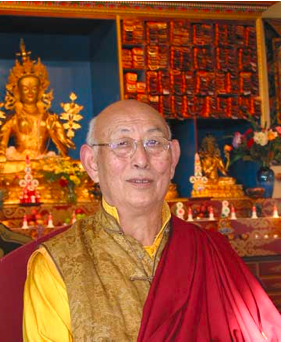Tulku Thubten Palzang Rinpoche
-

The most senior living lineage-holder of the Palyul Tradition, Tulku Thubten Palzang Rinpoche (“Tulku Thubzang Rinpoche”), was born in the year of the Fire Rat (1936). He was discovered by the great Khenpo Ngaga Rinpoche, the same Khenchen who confirmed the recognition of our late Holiness, Drubwang Pema Norbu Rinpoche.
Tulku Rinpoche has spent the majority of his life in Palyul, Kham, overseeing the rebuilding of Palyul Monastery. However, while making sure we have the physical buildings where all can study and practice the teachings, most important has been his activity to save and preserve the texts of teachings. Through great effort, personal danger and the blessings of all the lineage masters, Tulku Rinpoche has managed to collect texts that were nearly destroyed. The Kama teachings, for instance, were scattered in personal collections throughout the local area and the world. These he assembled in the Palyul Library, and had re-carved into wooden blocks based upon the copies. He has also preserved some of the original wooden printing blocks of the Nam Chö which remarkably had escaped destruction through being mistaken by those who would do so for firewood. The original pre-1959 library held wood blocks for 50 volumes. Thanks to Tulku Rinpoche’s hard work, and with the addition of the Kama teachings, the library today holds printing blocks of more than 110 volumes. It has likely become the world’s largest wood block library for texts related to Kama collected in one place. Because of this effort, His Holiness Penor Rinpoche was able to obtain the texts required to carry through the series of retreats known as Liberation in the Palm of Your Hand, now regularly given in Namdroling Monastery and in the US Retreat Center.
Biographies often mention that Tulku Thubzang Rinpoche is renowned for his expertise in the detailed instructions of all the ritual activities such as Mudra (hand gestures) and Cham (sacred lama dance). This understates his mastery. It is because of his capacity to know all of the most minute details of the elaborate rituals for Drupchen (twenty-four-hour a day, seven-day prayer ritual) and Accomplishment Ceremonies that these teachings have been preserved. He also knows how to play nearly all of the sacred musical instruments and has taught these. To understand the extent of his knowledge, we must know that ordinary aspirants generally can remember just one of the instruments. The monastic retreats within Palyul Monastery, Kham, are all also overseen by Tulku Rinpoche. Fortunately for us, Tulku Thubzang Rinpoche has been able to confer these teachings to hundreds of aspirants, insuring they are remembered for generations to come. In this way, granting teachings and empowerments based on these texts and based on his knowledge of all of the rituals of Palyul, Tulku Rinpoche has spent many years caring for and nurturing the entire Palyul lineage.
http://www.tibetanbuddhistaltar.org/2011/03/tulku-thubten-palzang-rinpoche/